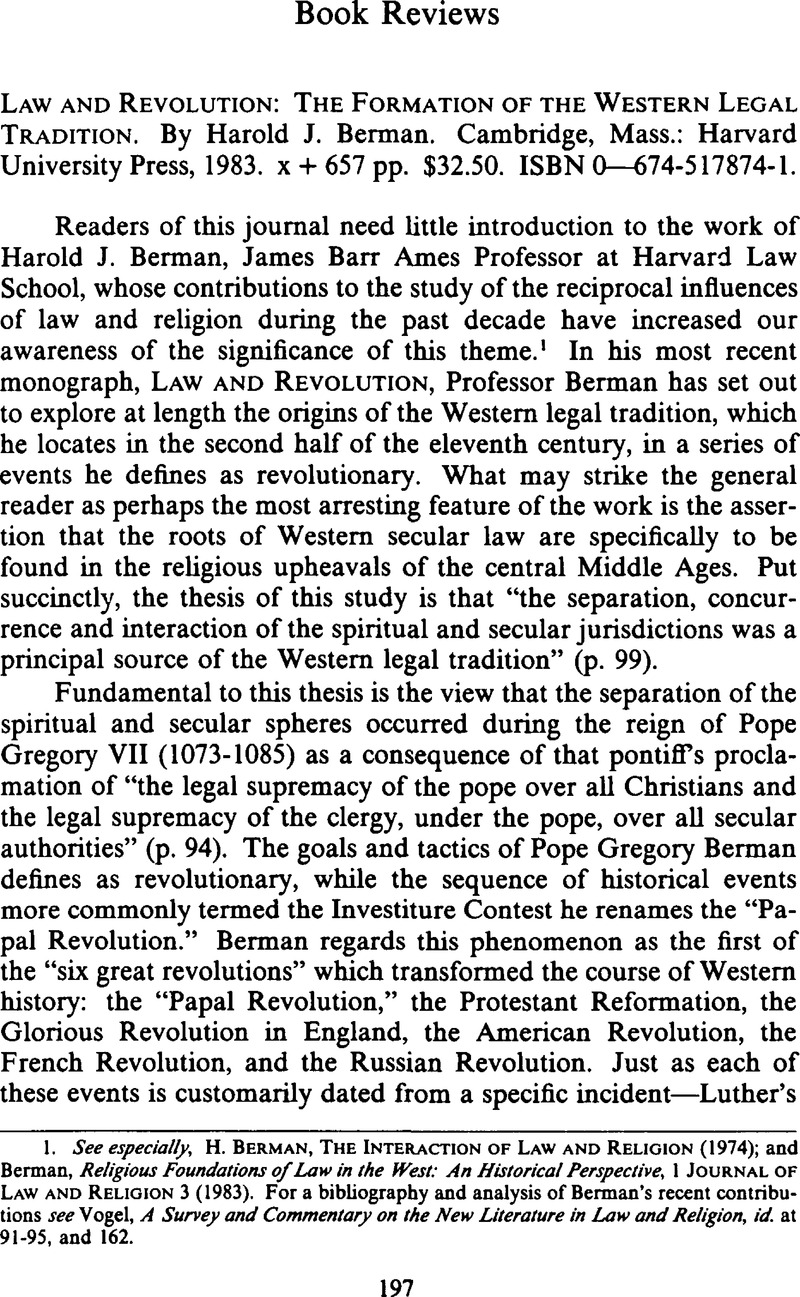No CrossRef data available.
Article contents
Law and Revolution: The Formation of the Western Legal Tradition. By Harold J. Berman. Cambridge, Mass.: Harvard University Press, 1983. x + 657 pp. $32.50. ISBN 0—674-517874-1.
Published online by Cambridge University Press: 03 February 2016
Abstract

- Type
- Book Reviews
- Information
- Copyright
- Copyright © Center for the Study of Law and Religion at Emory University 1984
References
1. See especially, Berman, H., The Interaction of Law and Religion (1974)Google Scholar; and Berman, , Religious Foundations of Law in the West: An Historical Perspective, 1 Journal of Law and Religion 3 (1983)CrossRefGoogle Scholar. For a bibliography and analysis of Berman's recent contributions see Vogel, A Survey and Commentary on the New Literature in Law and Religion, id. at 91-95, and 162.
2. Tierney, B., The Crisis of Church and State, 1050–1300 (1964)Google Scholar; Strayer, J. R., On The Medieval Origins of the Modern State (1970)Google Scholar.
3. The apparatus does not always reflect the current state of scholarship. For example, the discussion of purgatory (pp. 166-171) would have benefited from consulting LeGoff, J., La naissance du purgatoire (1981)Google Scholar; that on the law of marriage (pp. 226-230) from Sheehan, M., Marriage and Family in English Conciliar and Synodal Legislation in Essays in Honor of A. C. Pegis (O'Donnell, J.R. ed. 1974)Google Scholar, and Duby, G., Medieval Marriage: Two Models from Twelfth-Century France (1978)Google Scholar; that on the Collection in 74 Titles (p. 202) from Gilchrist, J., The Collection in 74 Titles: A Canon Law Manual of the Gregorian Reform (1980)Google Scholar; the whole discussion of royal law in the different European regions (chaps. 13-14, pp. 404-519) from Wolf, , Die Gesetzgebung der entstehenden Territorialstaaten in Europa, in Coing, H., Handbuch der Quellen und Literature der Neuren Europaischen Privatrechtsgeschichte I (1973)Google Scholar. This list could be extended.
4. Shieffer, , Cluny et la querelle des Investitures, Revue Historique 47–72 (1961)Google Scholar.
5. Tellenbach, G., Libertas: Kirche and Weltordnung im Zietalter der Investiturstreites (1936)Google Scholar, trans, by Bennett, R. F. as Church, State, and Christian Society at the Time of the Investiture Contest (1940)Google Scholar. Berman provides an extensive review of the literature on this theme (pp. 574-578).
6. Cantor, N., Church, Kingship, and Lay Investiture in England, 1089-1135 (1958) at 6CrossRefGoogle Scholar. Berman is aware that Cantor stated these views in general terms in his classroom textbook Medieval History (1963), but strangely fails to cite Cantor's fuller statement given above.
7. Duby, G., The Three Orders: Feudal Society Imagined (1980)Google Scholar.
8. Gilchrist, , The Reception of Pope Gregory VUinto the Canon Law (1073-1141), Zeitschrift der Savigny-Stiftung fur Rechtsgeschichte, Kan. Abt. 35–83 (1973)Google Scholar.
9. Gerhard, D., Old Europe: A Study of Continuity, 1000–1800 (1981)Google Scholar; Cipolla, C., Before the Industrial Revolution: European Society and Economy, 1000–1700 (1976)Google Scholar; Tierney, B., Religion, Law, and the Growth of Constitutional Thought, 1150–1650 (1982)Google Scholar.
10. See, Post, , A Romano-Canonical Maxim, Quod omnes tangit, in Bracton and in Early Parliaments, in Studies in Medieval Legal Thought (1964) at 163–238CrossRefGoogle Scholar; Hall, , King Henry III and the English Reception of the Roman Law Maxim Quod Omnes Tangit, Studia Gratiana 126–145 (1972)Google Scholar.
11. van Caenegem, , Public Prosecution of Crime in Twelfth-Century England, Studia Historica Gandensia 41–76, especially at 61–62 (1976)Google Scholar.




